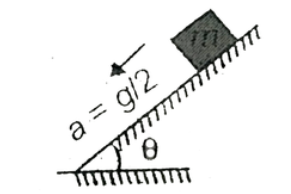In the case of a body sliding down a rough inclined plane show that μs=tanθ
To show that the coefficient of static friction (μ_s) is equal to tan(θ) for a body sliding down a rough inclined plane, we can follow these steps:
1. Identify Forces Acting on the Body:
- Consider a body of mass m sliding down an inclined plane at an angle θ to the horizontal. The forces acting on the body include:
- The gravitational force mg acting vertically downward.
- The normal force R acting perpendicular to the inclined surface.
- The frictional force F acting opposite to the direction of motion (up the incline).
2. Resolve the Gravitational Force:
- The weight mg can be resolved into two components:
- Perpendicular to the incline: mgcosθ
- Parallel to the incline: mgsinθ
3. Apply Newton's Second Law:
- In the direction perpendicular to the incline, the normal force R balances the perpendicular component of the weight:
R=mgcosθ(Equation 1)
- In the direction parallel to the incline, the frictional force F opposes the component of weight down the incline:
F=mgsinθ(Equation 2)
4. Relate Frictional Force to Normal Force:
- The frictional force F can also be expressed in terms of the coefficient of static friction μs and the normal force R:
F=μsR
5. Substitute Equations:
- From Equation 1, substitute R into the frictional force equation:
F=μs(mgcosθ)
6. Equate the Two Expressions for F:
- Set the two expressions for F equal to each other:
mgsinθ=μs(mgcosθ)
7. Simplify the Equation:
- Cancel mg from both sides (assuming m≠0):
sinθ=μscosθ
8. Solve for μ_s:
- Rearranging gives:
μs=sinθcosθ=tanθ
9. Conclusion:
- Therefore, we have shown that:
μs=tanθ
- Consider a body of mass m sliding down an inclined plane at an angle θ to the horizontal. The forces acting on the body include:
- The gravitational force mg acting vertically downward.
- The normal force R acting perpendicular to the inclined surface.
- The frictional force F acting opposite to the direction of motion (up the incline).
- The weight mg can be resolved into two components:
- Perpendicular to the incline: mgcosθ
- Parallel to the incline: mgsinθ
- In the direction perpendicular to the incline, the normal force R balances the perpendicular component of the weight:
R=mgcosθ(Equation 1)
- In the direction parallel to the incline, the frictional force F opposes the component of weight down the incline:
F=mgsinθ(Equation 2)
- The frictional force F can also be expressed in terms of the coefficient of static friction μs and the normal force R:
F=μsR
- From Equation 1, substitute R into the frictional force equation:
F=μs(mgcosθ)
- Set the two expressions for F equal to each other:
mgsinθ=μs(mgcosθ)
- Cancel mg from both sides (assuming m≠0):
sinθ=μscosθ
- Rearranging gives:
μs=sinθcosθ=tanθ
- Therefore, we have shown that:
μs=tanθ
Topper's Solved these Questions
- FRICTIONBOOK - ICSECHAPTER - FRICTIONEXERCISE - Very short answer question
9 Videos
- FRICTIONBOOK - ICSECHAPTER - FRICTIONEXERCISE - Selected problems
30 Videos
- FRICTIONBOOK - ICSECHAPTER - FRICTIONEXERCISE - Long answer questions
2 Videos
- DYNAMICSBOOK - ICSECHAPTER - DYNAMICSEXERCISE - SHORT ANSWER QUESTIONS WITH ANSWERS
12 Videos
- GRAVITATIONBOOK - ICSECHAPTER - GRAVITATIONEXERCISE - FROM THE HUBBLE TELESCOP
2 Videos
Similar Questions
Starting from rest, the time taken by a body sliding down on a rough inclined plane at 45∘ with the horizontal is twice the time taken to travel on a smooth plane of same inclination and same distance. Then, the coefficient of kinetic friction is
View SolutionDerive an expression for the acceleration of a body sliding down a rough inclined plane.
View Solution
Knowledge Check
When a body slides down from rest along a smooth inclined plane making an angle of 30∘ with the horizontal, it takes time 20s. When the same body slides down from rest along a rough inclined plane making the same angle and through the same distance, it takes time 20p is, where p is some number greater than 1. The coefficient of friction between the body and the rough plane is
Aμ=(1−1p2)1√3Bμ=(1−19p2)Cμ=(1−p2)1√3Dμ=√1−9p2
Discuss the possibility of conservation of linear momentum of a block moving on a rough inclined plane if μ=tanθ

View SolutionThe time taken by a body to slide down a rough 45∘ inclined plane is twice that required to slide down a smooth 45∘ inclined plane. The coefficient of kinetic friction between the object and rough plane is given by
View SolutionConsider the following A and B, and identify the correct choice in the given answers.
A) For a body resting on a rough horizontal table, it is easier to pull at angle that push at the same angle to cause motion
B) A body sliding down a rough inclined plane of inclination equal to angle of friction has nonzero acceleration
View SolutionA block of mass m slides down a rough inclined plane with an acceleration g2

View SolutionA body takes ''n'' times as much time to slide down a rough inclined plane as it takes to slide down an identical but smooth inclined plane. If the angle of inclination of the inclined plane is ''θ''. What is the coefficient of friction between the body and the rough plane ?
View SolutionA body takes 1(13) times as much time to slide down a rough inclined plane as it takes to slide down an identical bust smooth inclined plane. If the angle of inclination is 45°, find the coefficient of friction.
View SolutionWhen body slides down from rest along smooth inclined plane making angle of 45∘ with the horizontal, it takes time T When the same body slides down from rest along a rough inclined plane making the same angle and through the same distance it is seen to take time pT, where p is some number greater that 1. Calculate late the coefficient of friction beween the body and the rough plane.
 .
.
View Solution
